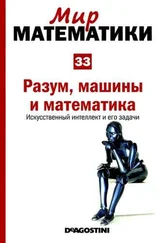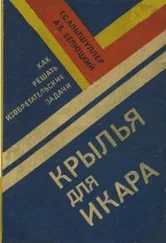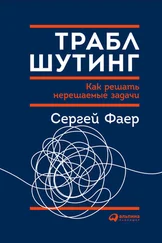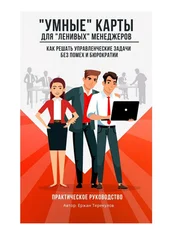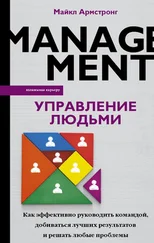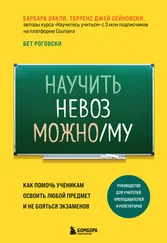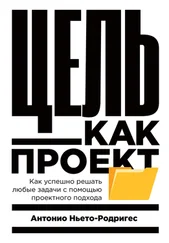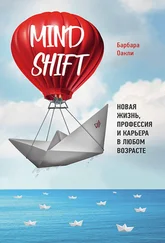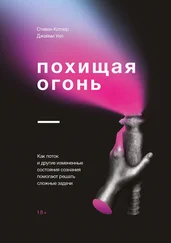Барбара Оакли - Думай как математик - Как решать любые задачи быстрее и эффективнее
Здесь есть возможность читать онлайн «Барбара Оакли - Думай как математик - Как решать любые задачи быстрее и эффективнее» — ознакомительный отрывок электронной книги совершенно бесплатно, а после прочтения отрывка купить полную версию. В некоторых случаях можно слушать аудио, скачать через торрент в формате fb2 и присутствует краткое содержание. Год выпуска: 2012, Жанр: Прочее, на русском языке. Описание произведения, (предисловие) а так же отзывы посетителей доступны на портале библиотеки ЛибКат.
- Название:Думай как математик: Как решать любые задачи быстрее и эффективнее
- Автор:
- Жанр:
- Год:2012
- ISBN:нет данных
- Рейтинг книги:4.67 / 5. Голосов: 3
-
Избранное:Добавить в избранное
- Отзывы:
-
Ваша оценка:
- 100
- 1
- 2
- 3
- 4
- 5
Думай как математик: Как решать любые задачи быстрее и эффективнее: краткое содержание, описание и аннотация
Предлагаем к чтению аннотацию, описание, краткое содержание или предисловие (зависит от того, что написал сам автор книги «Думай как математик: Как решать любые задачи быстрее и эффективнее»). Если вы не нашли необходимую информацию о книге — напишите в комментариях, мы постараемся отыскать её.
Думай как математик: Как решать любые задачи быстрее и эффективнее — читать онлайн ознакомительный отрывок
Ниже представлен текст книги, разбитый по страницам. Система сохранения места последней прочитанной страницы, позволяет с удобством читать онлайн бесплатно книгу «Думай как математик: Как решать любые задачи быстрее и эффективнее», без необходимости каждый раз заново искать на чём Вы остановились. Поставьте закладку, и сможете в любой момент перейти на страницу, на которой закончили чтение.
Интервал:
Закладка:
Oettingen, G., et al. “Turning fantasies about positive and negative futures into self-improvement goals.” Motivation and Emotion 29, 4 (2005): 236–266.
Oettingen, G., and J. Thorpe. “Fantasy realization and the bridging of time.” In Judgments over Time: The Interplay of Thoughts, Feelings, and Behaviors, edited by L. A. Sanna and E. C. Chang, 120–142. New York: Oxford University Press, 2006.
Oudiette, D., et al. “Evidence for the re-enactment of a recently learned behavior during sleepwalking.” PLOS ONE 6, 3 (2011): e18 056.
Pachman, M., et al. “Levels of knowledge and deliberate practice.” Journal of Experimental Psychology 19, 2 (2013): 108–119.
Partnoy, F. Wait. New York: Public Affairs, 2012.
Pashler, H., et al. “When does feedback facilitate learning of words?” Journal of Experimental Psychology: Learning, Memory, and Cognition 31, 1 (2005): 3–8.
Paul, A. M. “The machines are taking over.” New York Times, September 14 (2012). http://www.nytimes.com/2012/09/16/magazine/
how-computerized-tutors-are-learning-to-teach-
humans.html?pagewanted=all
Paul, A. M. “You’ll never learn! Students can’t resist multitasking, and it’s impairing their memory.” Slate, May 3 (2013). http://www.slate.com/articles/health_and_science/
science/2013/05/multitasking_while_studying_
divided_attention_and_technological_gadgets.3.html
Pennebaker, J. W., et al. “Daily online testing in large classes: Boosting college performance while reducing achievement gaps.” PLOS ONE 8, 11 (2013): e79 774.
Pert, C. B. Molecules of Emotion. New York: Scribner, 1997.
Pesenti, M., et al. “Mental calculation in a prodigy is sustained by right prefrontal and medial temporal areas.” Nature Neuroscience 4, 1 (2001): 103–108.
Pintrich, P. R., et al. “Beyond cold conceptual change: The role of motivational beliefs and classroom contextual factors in the process of conceptual change.” Review of Educational Research 63, 2 (1993): 167–199.
Plath, S. The Bell Jar. New York: Harper Perennial, 1971.
Prentis, J. J. “Equation poems.” American Journal of Physics 64, 5 (1996): 532–538.
President’s Council of Advisors on Science and Technology. Engage to Excel: Producing One Million Additional College Graduates with Degrees in Science, Technology, Engineering, and Mathematics. 2012. http://www.whitehouse.gov/sites/default/files/microsites/ostp/pcast-engage-to-excel-final_feb.pdf
Pyc, M. A., and K. A. Rawson. “Why testing improves memory: Mediator effectiveness hypothesis.” Science 330, 6002 (2010): 335–335.
Raichle, M. E., and A. Z. Snyder. “A default mode of brain function: A brief history of an evolving idea.” NeuroImage 37, 4 (2007): 1083–1090.
Ramachandran, V. S. Phantoms in the Brain. New York: Harper Perennial, 1999.
Ramón y Cajal, S. Advice for a Young Investigator. Translated by N. Swanson and L. W. Swanson. Cambridge, MA: MIT Press, 1999 [1897].
Ramón y Cajal, S. Recollections of My Life. Cambridge, MA: MIT Press, 1937. Originally published as Recuerdos de Mi Vida, translated by E. H. Craigie (Madrid, 1901–1917).
Rawson, K. A., and J. Dunlosky. “Optimizing schedules of retrieval practice for durable and efficient learning: How much is enough?” Journal of Experimental Psychology: General 140, 3 (2011): 283–302.
Rivard, L. P., and S. B. Straw. “The effect of talk and writing on learning science: An exploratory study.” Science Education 84, 5 (2000): 566–593.
Rocke, A. J. Image and Reality. Chicago: University of Chicago Press, 2010.
Roediger, H. L., and A. C. Butler. “The critical role of retrieval practice in long-term retention.” Trends in Cognitive Sciences 15, 1 (2011): 20–27.
Roediger, H. L., and J. D. Karpicke. “The power of testing memory: Basic research and implications for educational practice.” Perspectives on Psychological Science 1, 3 (2006): 181–210.
Roediger, H. L., and M. A. Pyc. “Inexpensive techniques to improve education: Applying cognitive psychology to enhance educational practice.” Journal of Applied Research in Memory and Cognition 1, 4 (2012): 242–248.
Rohrer, D., Dedrick, R. F., & Burgess, K. (in press). The benefit of interleaved mathematics practice is not limited to superficially similar kinds of problems. Psychonomic Bulletin & Review.
Rohrer, D., and H. Pashler. “Increasing retention without increasing study time.” Current Directions in Psychological Science 16, 4 (2007): 183–186.
Rohrer, D., and H. Pashler. “Recent research on human learning challenges conventional instructional strategies.” Educational Researcher 39, 5 (2010): 406–412.
Root-Bernstein, R. S., and M. M. Root-Bernstein. Sparks of Genius. New York: Houghton Mifflin, 1999.
Ross, J., and K. A. Lawrence. “Some observations on memory artifice.” Psychonomic Science 13, 2 (1968): 107–108.
Schoenfeld, A. H. “Learning to think mathematically: Problem solving, metacognition, and sense-making in mathematics.” In Handbook for Research on Mathematics Teaching and Learning, edited by D. Grouws, 334–370. New York: Macmillan, 1992.
Schutz, L. E. “Broad-perspective perceptual disorder of the right hemisphere.” Neuropsychology Review 15, 1 (2005): 11–27.
Scullin, M. K., and M. A. McDaniel. “Remembering to execute a goal: Sleep on it!” Psychological Science 21, 7 (2010): 1028–1035.
Shannon, B. J., et al. “Premotor functional connectivity predicts impulsivity in juvenile offenders.” Proceedings of the National Academy of Sciences 108, 27 (2011): 11 241–11 245.
Shaw, C. A., and J. C. McEachern, eds. Toward a Theory of Neuroplasticity. New York: Psychology Press, 2001.
Silverman, L. Giftedness 101. New York: Springer, 2012.
Simon, H. A. “How big is a chunk?” Science 183, 4124 (1974): 482–488.
Simonton, D. K. Creativity in Science. New York: Cambridge University Press, 2004.
Simonton, D. K. Scientific Genius. New York: Cambridge University Press, 2009.
Sklar, A. Y., et al. “Reading and doing arithmetic nonconsciously.” Proceedings of the National Academy of Sciences 109, 48 (2012): 19 614–19 619.
Smoker, T. J., et al. “Comparing memory for handwriting versus typing.” In Proceedings of the Human Factors and Ergonomics Society Annual Meeting, 53 (2009): 1744–1747.
Solomon, I. “Analogical transfer and ‘functional fixedness’ in the science classroom.” Journal of Educational Research 87, 6 (1994): 371–377.
Spear, L. P. “Adolescent neurodevelopment.” Journal of Adolescent Health 52, 2 (2013): S7– S13.
Steel, P. “The nature of procrastination: A meta-analytic and theoretical review of quintessential self-regulatory failure.” Psychological Bulletin 133, 1 (2007): 65–94.
Steel, P. The Procrastination Equation. New York: Random House, 2010.
Stickgold, R., and J. M. Ellenbogen. “Quiet! Sleeping brain at work.” Scientific American Mind 19, 4 (2008): 22–29.
Sweller, J., et al. Cognitive Load Theory. New York: Springer, 2011.
Takeuchi, H., et al. “The association between resting functional connectivity and creativity.” Cerebral Cortex 22, 12 (2012): 2921–2929.
Takeuchi, H., et al. “Failing to deactivate: The association between brain activity during a working memory task and creativity.” NeuroImage 55, 2 (2011): 681–687.
Taylor, K., and D. Rohrer. “The effects of interleaved practice.” Applied Cognitive Psychology 24, 6 (2010): 837–848.
Thomas, C., and C. I. Baker. “Teaching an adult brain new tricks: A critical review of evidence for training-dependent structural plasticity in humans.” NeuroImage 73 (2013): 225–236.
Thompson-Schill, S. L., et al. “Cognition without control: When a little frontal lobe goes a long way.” Current Directions in Psychological Science 18, 5 (2009): 259–263.
Читать дальшеИнтервал:
Закладка:
Похожие книги на «Думай как математик: Как решать любые задачи быстрее и эффективнее»
Представляем Вашему вниманию похожие книги на «Думай как математик: Как решать любые задачи быстрее и эффективнее» списком для выбора. Мы отобрали схожую по названию и смыслу литературу в надежде предоставить читателям больше вариантов отыскать новые, интересные, ещё непрочитанные произведения.
Обсуждение, отзывы о книге «Думай как математик: Как решать любые задачи быстрее и эффективнее» и просто собственные мнения читателей. Оставьте ваши комментарии, напишите, что Вы думаете о произведении, его смысле или главных героях. Укажите что конкретно понравилось, а что нет, и почему Вы так считаете.


